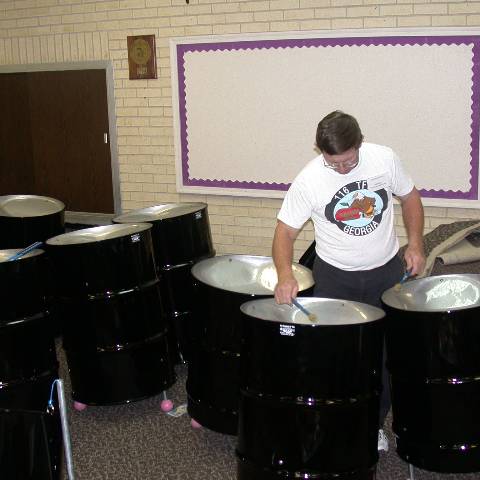A longtime dream of Bill King, instrumental music teacher for Lower, Middle, and Upper schools, to purchase and teach steel drums has been realized. This summer his dream came true as 18 steel drums arrived on campus from West Virginia.
“I purchased steel drums for East Rome Junior High School to use in 1981 and haven’t played them since leaving that school,” King said. “Our program here at Darlington has matured and we have students with musical expertise to the point where I felt we were ready to add steel drums to our program.” This school year, King is conducting a second-period steel drum class and an after-school activity.
“We will be the only high school performing with steel drums in the local area,” King said. The steel drum band will first perform on Oct. 31 in the Morris Chapel at 10:40 a.m. and will travel to Jamaica in February to perform along with the Wind Ensemble and the Concert Choir. Concerts will be performed at a local school, Sam Sharpe Square, and at the Calvary Baptist Church in Montego Bay, Jamaica in conjunction with the School's admission and development offices.
King picked up the drums at Mannette Steel Drums, Ltd, and, while there, studied and brushed up on his tuning and performance techniques with Eliott (Ellie) Mannette, the designer and individual who built the drums. Mannette is actually the creator of the entire art form of steel band music and an artist-in-residence and director of steel band studies at West Virginia University.
Living in the Caribbean, Mannette started out at age 11, beating on garbage cans, small cans, and buckets, creating rhythms and sounds his ear enjoyed. By age 16, he had managed to transform a 55-gallon garbage can with a concave inside capable of playing up to 32 and one-half notes.
In 1946, he won first prize in a contest in which he played “Brahms’ Lullaby” and “Laura” on a steel drum, the first time he allowed anyone to see or hear his creation. Following that concert, and many years of hard work spent in refining the steel drum, he was awarded Trinidad’s highest medals of distinction, “The Pegasus” and “The Hummingbird.” His work has been displayed in the Smithsonian, the Metropolitan Museum, and the Contemporary Art Gallery.
The steel drum evolved out of an assortment of metal containers that produced a cacophony of metallic sounds. The rhythmic pulse was maintained by striking a brake drum with a piece of iron. In their infancy, drums were made from small steel containers whose tops had been hammered into convex shapes.
Different pitches were then achieved by sinking small portions of the surface downward achieving concave notes on a convex surface, exactly the opposite of the contemporary steel drum. Mannette is credited with the reversal of the sinking process in 1941.
And so, what was once a young boy’s hobby has transpired into a playground of bigger adventures. For Mannette, it is the love of invention, artistry, and creativity.
“All I ever wanted to do was design and create the steel drums,” he said. “It’s an orchestra from steel, unique in quality and strange in character.” For Darlington it is the beginning of an exciting and new addition to a rapidly growing instrumental music program.

